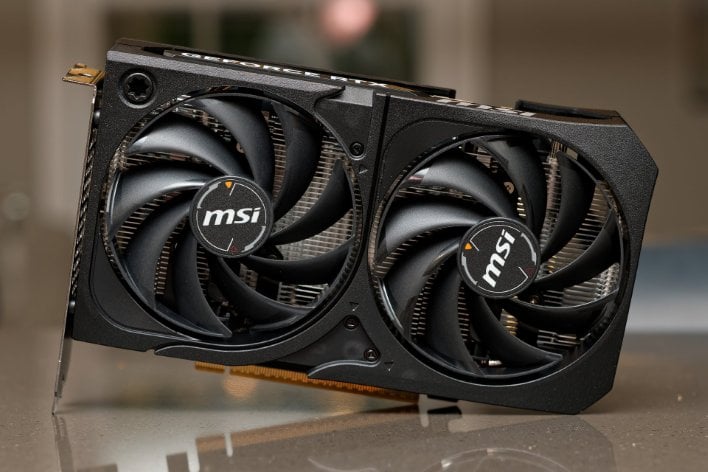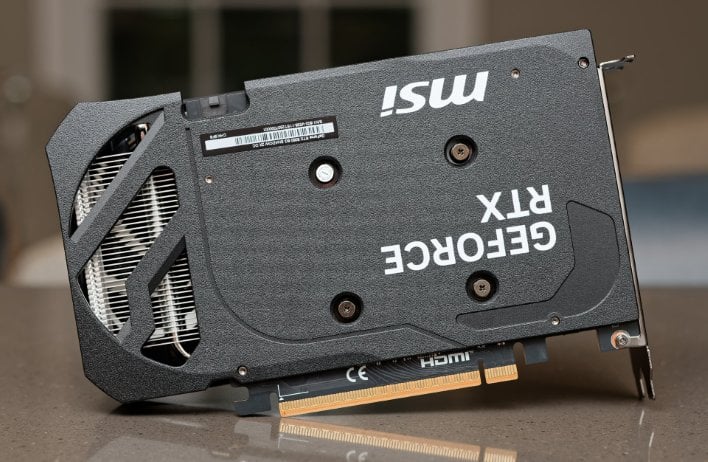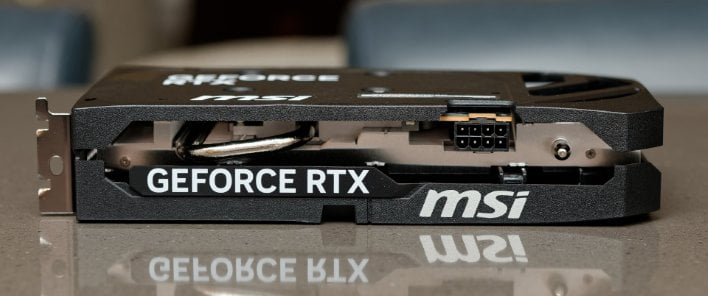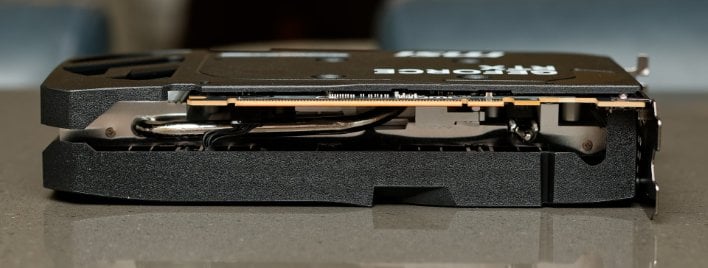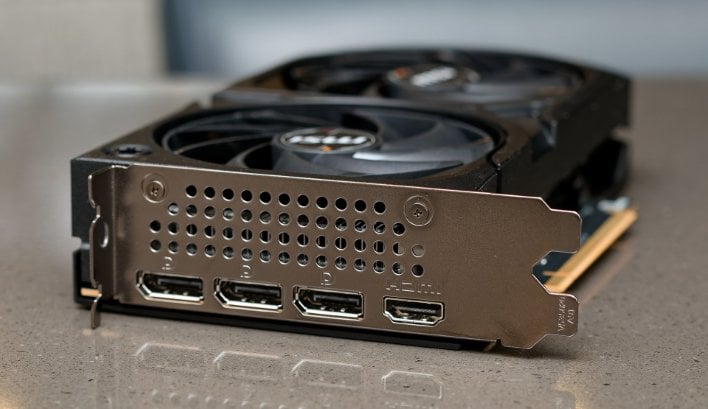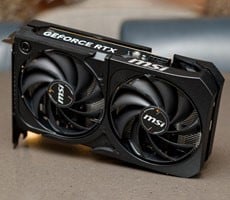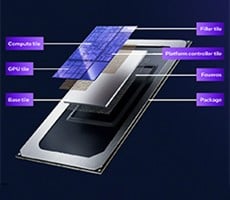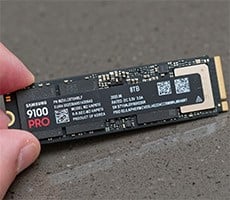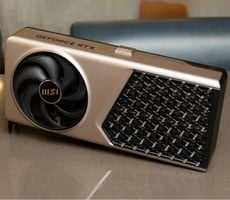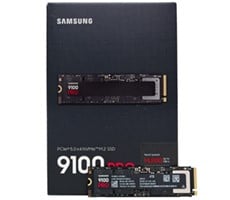MSI GeForce RTX 5050 Shadow 2X Review: Budget Blackwell Gaming Tested
| MSI GeForce RTX 5050 Shadow 2X 8GB: $249 The GeForce RTX 5050 is the most-affordable graphics card based on NVIDIA's Blackwell architecture that targets mainstream gamers, and is the first RTX XX50 series GPU for the desktop in years.
|
|||

|

|
||
Although updated models and some new Super cards will likely be coming to the GeForce RTX 50 series for desktops, at this point in time, NVIDIA is done building out its primary GeForce RTX 50 series product stack. We’ve taken a look at every model to date, from the flagship GeForce RTX 5090 on down to the mainstream GeForce RTX 5060. Today though, we’re checking out the entry-level GeForce RTX 5050, with a card from MSI. If you recall, there was no RTX 4050 series desktop GPU with the previous generation. With the RTX 50 series, however, due to its expanded feature set, updated core architectures, and enhanced media engine, NVIDIA thought a GeForce RTX 5050 was warranted – so, here we are.
The actual card we’ll be checking out is the MSI GeForce RTX 5050 Shadow 2X. The branding gives away much of the story – the Shadow 2X is a dual-slot, dual-fan design -- but here’s a quick look at the main features and specifications, before we get more up close and personal and dive into some benchmarks...
MSI GeForce RTX 5050 Specifications
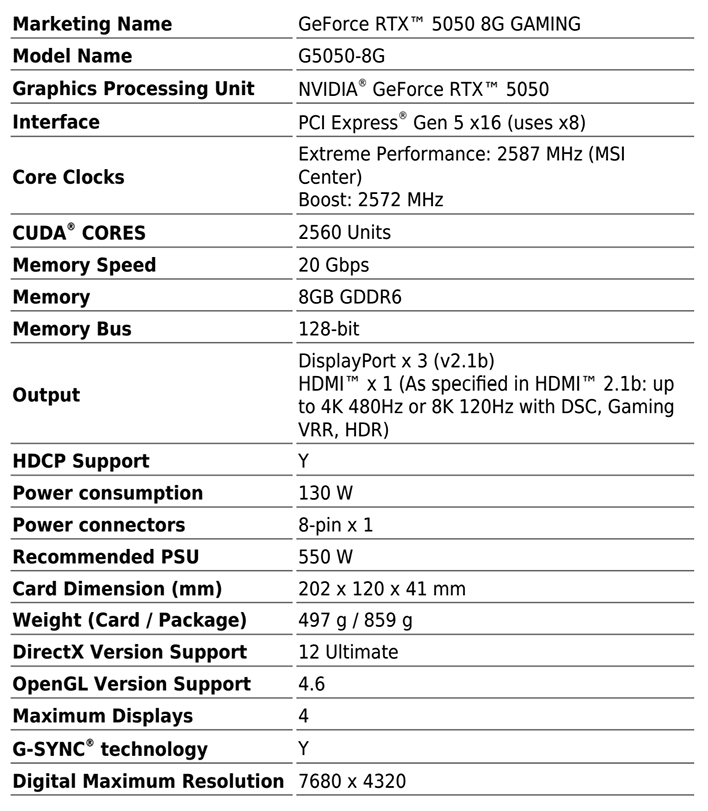
If you haven’t already done so, we recommend checking out our Blackwell architecture coverage and a couple of previous GeForce RTX 50 series reviews. There are many additional GPU details we’ve covered previously that we won’t re-hash again here. To quickly reiterate, GeForce RTX 5050 cards are built around NVIDIA's GB207 GPU, which is the smallest, most power-friendly Blackwell-based GPU in the current RTX 50-series line-up.
The GB207 GPU powering the MSI GeForce RTX 5050 Shadow 2X is identical to its larger siblings in terms of it feature support. It offers the entirety of features inherent to the Blackwell architecture, like DLSS 4 with multi-frame-gen, the latest NVENC/NVDEC encoders and decoders, and support for other NVIDIA technologies like NVIDIA Reflex, to name just a few. However, NVIDIA's GB207 is scaled down to address lower power and performance targets with a lower price point.
The GB207 as configured on the GeForce RTX 5050 has 20 SMs, 2,560 CUDA cores, 80 Tensor cores, and 20 RT cores, with a 128-bit memory interface. NVIDIA's reference specs call for a typical boost clock in the 2,460MHz range (this MSI card runs faster, though) and the 8GB of GDDR6 memory on the card operates at an effective data rate of 20Gbps, which equates to just over 320GB/s of memory bandwidth over the card's 128-bit memory interface. The larger L2 cache in Blackwell GPUs (32MB in the GB207) versus previous-gen offerings, however, results in more efficient use of that memory bandwidth as well.
The MSI GeForce RTX 5050 Shadow 2X
In terms of its features and specifications, the MSI GeForce RTX 5050 Shadow 2X closely matches NVIDIA’s reference spec save for its max boost frequency. Obviously, all GeForce RTX 5050s are powered by the same GPU, but they also have identical memory configurations. Coolers and PCB designs will vary from card to card and among board partners, however.Getting back to the MSI GeForce RTX 5050 Shadow 2X, it offers two modes of operation, and "Extreme Performance" mode with a 2,617MHz boost clock and a standard mode with a 2,610MHz boost clock. Note, however, that to enable Extreme Performance, you must install the MSI Center utility.
The MSI GeForce RTX 5050 Shadow 2X features a more traditional-looking dual-fan cooler setup, with both fans mounted on the same side. And overall, the graphics card is somewhat compact at about 7.75”. If you look closely at the pictures, however, you’ll note that the MSI GeForce RTX 5050 Shadow 2X’s PCB is much shorter than the cooler. The PCB actually ends right alongside the PCIe power connector. Note, there’s no 12HPWR connector on this card, in favor of a standard 8-pin PCIe connector.
The main heatsink on the card is all aluminum, with a dense array of fins that essentially covers the entire front side of the board. That heatsink is mounted directly to the GPU and makes contact with the VRM and memory, and there’s a heatpipe that helps wick heat away from the GPU directly, and route it to the far edges of the heatsink.
The fans on the card blow directly onto the heatsink, where some of the air will be exhausted from the chassis through the case bracket, and the rest travels through the heatsink, similar to other graphics cards with pass-through cooling designs.
The backside of the MSI GeForce RTX 5050 Shadow 2X is covered with a stylized plate, which is made of metal, unlike some low-priced cards that use plastic. The entire fan shroud is made of plastic composite material, and the card is relatively lightweight and won’t need the same kind of structural support of heavier, higher-end cards.
The MSI GeForce RTX 5050 Shadow 2X is only two slots wide and uses a standard 8-pin PCI Express power connector. Total board power is 130W, so that one PCIe 8-pin connector (150W) plus the 75W available from the slot, is plenty and offers a ton of headroom, though there’s not a lot of wiggle room for overclocking, as you’ll see later.
As for its output configuration, the MSI GeForce RTX 5050 Shadow 2X is identical to most other mainstream designs, with three DisplayPorts (DP 2.1b) and a single HDMI (also 2.1b) output.
And with that, let’s get to some benchmarks...

